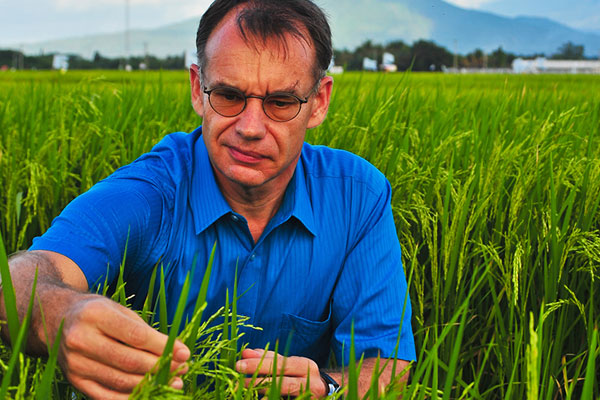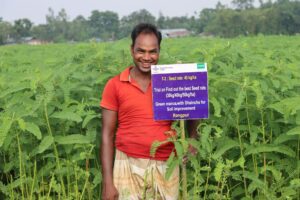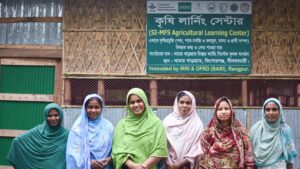
In 2015, the Global Rice Science Partnership (GRiSP) enters its 5th year, and is gearing up to the development of a phase II proposal for 2017 and beyond. Thus, this is a good time to take stock of accomplishments so far and discuss where we want to go next.
To recall, GRiSP is a CGIAR Research Program led by International Rice Research Institute (IRRI), and coordinated by six research-for-development organizations: IRRI, Africa Rice Center (AfricaRice), International Center for Tropical Agriculture (CIAT), Centre de Cooperation lnternationale en Recherche Agronomique pour le Développement (Cirad), lnstitut de Recherche pour le Développement (IRD), and the Japan International Research Center for Agricultural Sciences (JIRCAS).
These six organizations have fully aligned their rice R&D activities and share the same vision, mission, objectives, and R&D structure. Under the umbrella of GRiSP, they bring together over 900 partners from the academic, public, private, and civil society with a stake in the rice development sector. Their joint mission is to reduce poverty and hunger, improve human health and nutrition, reduce the environmental footprint, and enhance ecosystem resilience of rice production systems.
To gauge the achievements and success of GRiSP so far, we really need to ask the following questions: “What did the collective of research organizations achieve that they would not have achieved without GRiSP?” “And what has been the added value of the partnership approach?”
And the truth is—when traveling across the globe—I’ve seen the successes of the GRiSP partnership blossom up everywhere it is active! The collaboration among institutes and staff across the continents is unprecedented, leading to enormous exchanges of ideas, information, knowledge and technologies, and to new collaborative efforts and mechanisms.
In the field of variety development, for example, breeders are combining forces to modernize their programs so they are more efficient, more effective, and they can deliver improved varieties faster than ever before. Under the banner of accelerating genetic gain, AfricaRice, CIAT, and IRRI are designing novel breeding strategies that reap the fruits of the rapid advances in genomics. They share rice germplasm across the continents and pick the best genes and varieties for testing in their respective environments.
While I was in Peru, a national seed company showed me an experimental field with promising hybrid parental lines that were developed in Asia and made available through GRiSP. Back in the Philippines, IRRI has tested hybrid parental lines from Latin America and germplasm from Africa, broadening the genetic base for improvement.
Moreover, a global network of phenotyping platforms–in Africa, Asia, Australia, Europe, and North and Latin America–characterizes novel germplasm under a wide range of environmental conditions, using standardized protocols and sharing data for genome wide analyses.
Also in other fields, such as agronomy and natural resources management, ideas, tools and technologies are shared and co-developed. In Latin America, our partners in CIAT in Colombia and the National Institute of Agricultural Research (INIA) in Uruguay are applying crop growth simulation models, which have been developed at IRRI and by Wageningen University to explore the impacts of weather conditions and climate change on rice production. GRiSP facilitated this through exchange visits and organizing training courses.
In Africa and Asia, GRiSP scientists from AfricaRice, IRRI, and the national systems are developing rice management advisory tools delivered through mobile phones and internet applications. GRiSP-sponsored workshops and exchange visits catalyzed collaboration across continents on topics such as agronomy, innovation platforms, postharvest, value adding, grain quality, and rice supply and demand analyses.
Specialized expertise on rice diseases at Cirad and IRD is being tapped to help solve rice disease problems in Africa, while JIRCAS strengthens GRiSP with new discoveries of genetic traits such as those governing phosphorus uptake and high-yielding ability.
So, when looking ahead to GRiSP phase II, we will keep catalyzing cross-institutional and cross-continental collaboration. We will explore mechanisms to expand the global partnership concept by drawing in more allies and providing more opportunities for collaboration. We will develop partnerships on equal footing, whereby we subscribe to common goals and objectives; commit to joint research and development outcomes; and assume joint accountabilities for our ultimate goals of poverty alleviation, food and nutritional security, and a sustained and healthy resource base!
_________________________________________
Dr. Bouman is the director of GRiSP.








